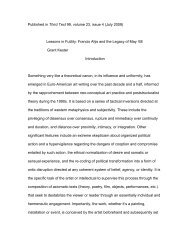Old Masters and New Lessons - Grant Kester
Old Masters and New Lessons - Grant Kester
Old Masters and New Lessons - Grant Kester
Create successful ePaper yourself
Turn your PDF publications into a flip-book with our unique Google optimized e-Paper software.
eexamine the origins of the aesthetic in early modern philosophy. What they have found there is<br />
a concept of aesthetic knowledge that is rooted in both the private body <strong>and</strong> the body politic. In<br />
fact, it is in the very nature of the aesthetic that it is located at the intersection between the<br />
experience of subjective autonomy <strong>and</strong> the subject-positions provided by a dominant culture.<br />
Hickey's book did much to reignite interest in the powerful visual experience provided by<br />
the work of art, but his argument loses its focus at precisely the point at which this experience<br />
engages with broader forms of discursive knowledge <strong>and</strong> public subjectivity. Hickey begins his<br />
book by evoking a nightmarishly Orwellian scenario in which a politically correct thought police<br />
dominate a well-funded network of "alternative" art spaces. This liberal elite, painfully out of<br />
touch with the vox populi of good old-fashioned bodily experience, have shackled the<br />
subversively beautiful art object in the basement in order to satisfy their fiendish desire to<br />
improve <strong>and</strong> infantilize the museum-going public. Hickey establishes a curious parallel between<br />
the alternative arts sector <strong>and</strong> the world of private galleries <strong>and</strong> auction houses. Thus, a<br />
"massive civil service" of arts administrators in charge of a vast apparatus of "publicly funded"<br />
exhibition spaces is juxtaposed to a "h<strong>and</strong>ful" of beleaguered dealers <strong>and</strong> gallery owners, who,<br />
if somewhat too ready to "nibble canapes on the Concorde," are at least honest about their<br />
relationship to the market <strong>and</strong> are more than willing to embrace the ambiguous pleasures of<br />
aesthetic desire.(4) The fact that this characterization could be persuasively advanced at a time<br />
when literally dozens of nonprofit exhibition spaces, publications, <strong>and</strong> media centers were being<br />
forced to close owing to drastic funding cuts <strong>and</strong> conservative political attacks suggests the<br />
emotional power of Hickey's underlying message for many in the art world.<br />
Hickey's essays deploy all the accouterments of classic bohemianism; "the street" is a<br />
persistent point of reference, along with sneering references to sc<strong>and</strong>alized "church ladies."(5)<br />
We find him rifling through Mapplethorpe's "X" portfolio in a "coke dealer's penthouse," or<br />
evoking the origins of Mapplethorpe's work in "smoky, crowded rooms with raw brick walls [<strong>and</strong>]<br />
sawhorse bars."(6) Hickey poses as a kind of critic provocateur, hurling his "outrageous" epithets<br />
at the indifferent monolith of the art establishment.(7) At the center of this avant-garde mise en<br />
scene is the artwork that magically eludes any deadening "institutional" mediation to strike up a<br />
direct <strong>and</strong> spontaneous relationship with the viewer. This exchange may take place in a




